| The
1916 Zeppelin Raids. By Bev Parker |
|
On 31st January, 1916, seventeen
months into the First World War, the Black Country
unexpectedly experienced the might of the German armed
forces at first hand, when two Zeppelins carried out
bombing raids, and terrorised the civilian population.
The German military were getting
increasingly confident after several raids on the east
coast and London, and planned an audacious attack on
Liverpool involving nine Zeppelins, and a flight of over
130 miles across England. The airships left their bases
on the afternoon of 31st January for a round flight of
nearly 1,000 miles, and initially everything went well.
The North Sea was crossed without incident, but on
reaching Norfolk they encountered mist and fog, and were
soon hopelessly lost. Airborne navigation relied on
observation and careful plotting on maps, recording air
speed against time. All that they could rely on was an
occasional break in the fog.
Two of the airships, L21 and L19
both made the same navigational error, and ended up over
the Black Country. The first to arrive, L21, was
captained by 45 years old Max Dietrich, an uncle of the
famous singer and actress, Marlene Dietrich. The vast
Zeppelin must have been an awesome sight. It was just
over 536 feet long, and 61 feet in diameter. It had a
top speed of 60 mph.
|
|

Landing a Zeppelin. From an old postcard. |
|
Using his maps, Dietrich plotted
his way across the country, soon hoping to see the
lights of Manchester, followed by Liverpool and the
Mersey. At 5.25pm. the L21 was spotted above King's
Lynn, and was seen over Derby at 6.55pm. News of the
airship's approach had already reached Derby and so the
town was blacked out. L21 then crossed Rugeley and was
spotted above Merridale Lane, in Wolverhampton at half
past seven. The airship then turned southwards to cross
Wombourne,
Kingswinford and Brierley Hill.
As Dietrich reached the Black Country, he saw lights,
and reflections, possibly from one of the many canals,
and assumed that he was near his target. The crew was
ready, and bombs were prepared for dropping. As the
airship passed over Netherton, Dietrich spotted William
Grazebrook's Ironworks and a bomb was dropped, but it
completely missed its target. L21 then turned northwards
and crossed Dudley before arriving at Tipton around
8.00pm. More lights were spotted
and the carnage began. The L21 arrived on a foggy and
frosty night above Tipton. Three high-explosive bombs
were dropped on Waterloo Street and Union Street,
destroying two houses, damaging several others, and
setting a gas main alight.
That evening the ‘Tivoli’ Cinema in
Owen Street was full to capacity. Around 1,400 people
were watching the film when the bombs started to fall.
One member of the audience, Thomas Morris, suffered
terribly. Earlier that evening his wife Sarah Jane had
taken his children to visit her mother in Union Street.
When Thomas heard the nearby explosions, he immediately
made his way to Union Street, only to discover that the
house had suffered from a direct hit, and was completely
destroyed. Inside he found the bodies of his wife, his
children, and his parents-in-law. Three generations of
the family were dead. It’s hard to imagine Thomas
Morris’s agony and despair at the time.
|

The blue plaque that's
on a shop front in Union Street, Tipton. |
Fourteen people
were killed at Tipton, five men, five women, and four
children. They were: Elizabeth Cartwright aged 35,
Thomas Henry Church aged 57, Arthur
Edwards aged 26, Benjamin Goldie aged 42, Mary Greensill
aged 67, William Greensill aged 64, Martin Morris aged
11, Nellie Morris aged 8, Sarah Jane Morris aged 44, George H.
Onions aged 12, Daniel Whitehouse aged 34, Annie
Wilkinson aged 44, Frederick Norman Yates aged 9, and
Louisa York aged 30. |
The L21 then dropped two bombs on
the railway station in Owen Street. They landed between
the station and the canal towpath, causing extensive
damage.
|
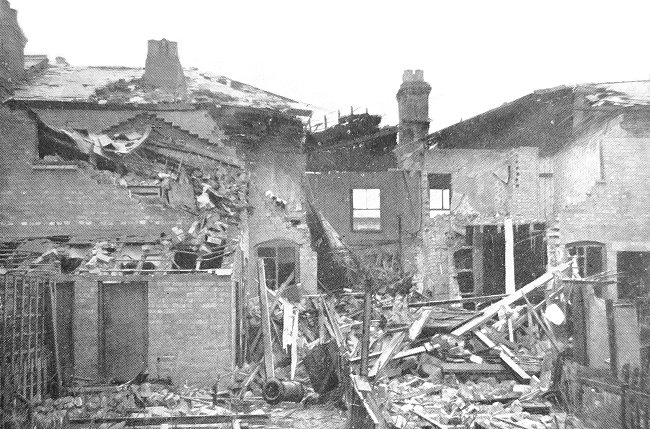
Some of the
destruction. From Lloyd's News, 13th
February, 1916. |
|
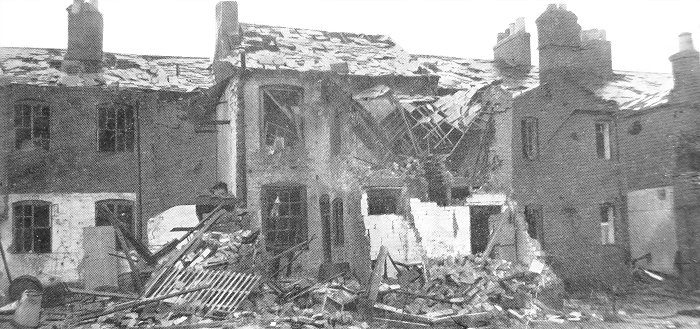
Another image from
Lloyd's News, 13th February, 1916. |
|
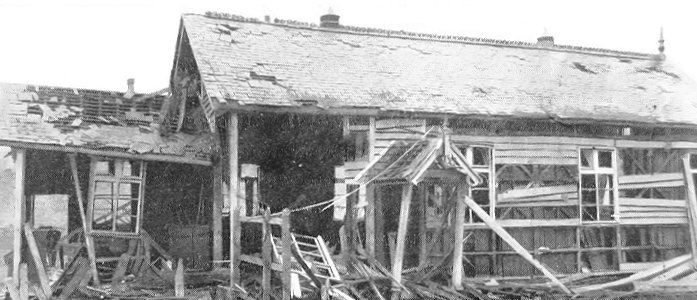
Another image from
Lloyd's News, 13th February, 1916. |
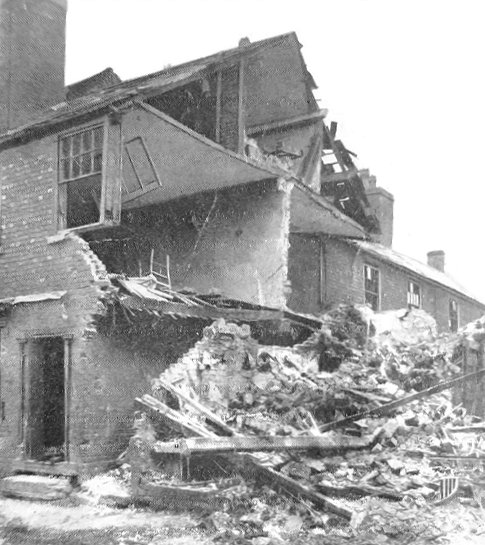 |
Another image from
Lloyd's News, 13th February, 1916. |
| A final image from
Lloyd's News, 13th February, 1916. |
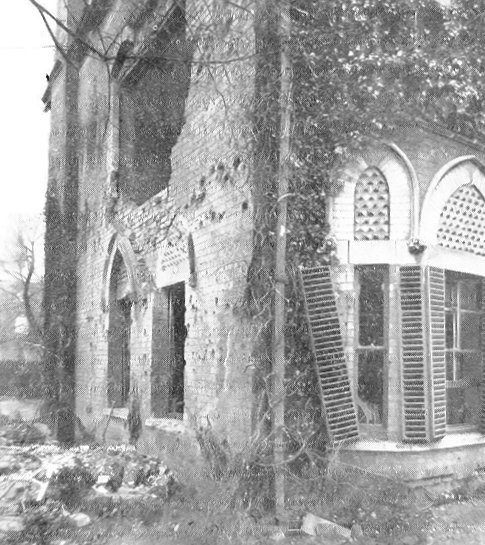 |
|
|
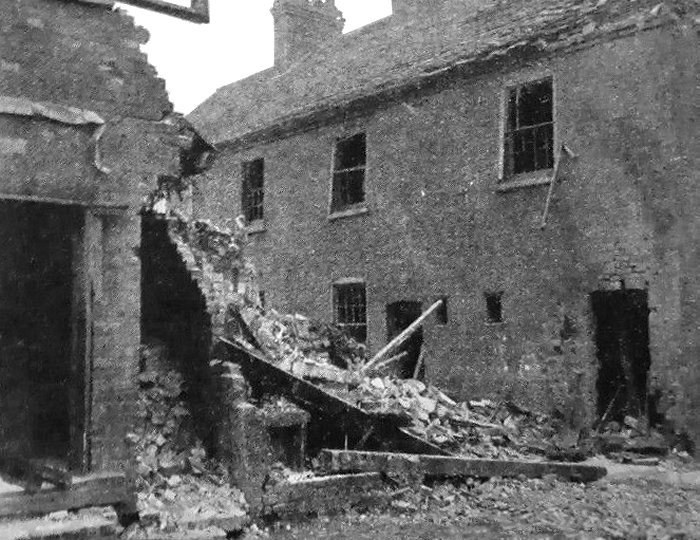
The remains of houses in Union
Street, Tipton. |
| The airship then flew over
Bloomfield Road and Barnfield Road, dropping incendiary
bombs on the way. Three landed in gardens in Bloomfield
Road and failed to ignite and three were dropped on
Bloomfield Brickworks. L21 then continued
northwards to the canal at Bradley, where a young
courting couple had gone for a stroll. William Fellows,
aged 23 from Coseley, and his 23 years old girlfriend
Maud Fellows from Bradley, were walking along the
towpath near to Bradley pumping station. They took
shelter when they heard the roar of the oncoming
airship. As it approached, the crew would have seen the
lights around Bradley, and so the bombing started again.
Sadly one of the bombs landed near to the young couple,
killing William outright, and fatally injuring Maud, who
was taken to the 'Old Bush Inn' where she received first
aid. From there she was taken to the Wolverhampton and
Staffordshire General Hospital, where she died of
septicaemia on 12th February. Their deaths are
commemorated by a small plaque on the pumping station
wall. |
|

A Zeppelin in flight. From an old
postcard. |
|
After crossing the canal, the
Zeppelin travelled eastwards towards Lea Brook and
Wednesbury. Dietrich would have seen the lights of
Wednesbury in the distance as the airship crossed over
the dark area of Lea Brook. A possible glimpse of the
canal could have convinced him that he was finally
reaching Liverpool. Around 8.15 that evening he headed
towards the brightly lit town centre and soon reached
Russell’s Crown Tube Works, where the bombing
recommenced. The incendiary bombs set the huge factory
alight, leaving a burnt-out shell, parts of which
remained until the 1960s.
King Street ran alongside Crown
Tube Works, and was the site of the next atrocity. The
Smith family, who lived at number 14 King Street were
greatly troubled by a loud noise near their home. Mrs.
Smith left the house to investigate, and soon saw a fire
at the works, which she assumed to have been caused by
an accident in the factory. She turned round and headed
back home, but by then the airship had moved over the
factory and dropped another bomb, which completely
destroyed number 13, and badly damaged number 14,
instantly killing her family. Later that night the
bodies of her husband Joseph Horton Smith, aged 37, her
daughter Nellie, aged 13, and her son Thomas, aged 11
were found amongst the ruins. The body of her other
daughter Ina, aged 7 wasn't found until the next
morning. She had been blown onto the roof of the tube
factory.
While the bombs were falling, the
audience at the King’s Hall, in Earps
Lane were enjoying a melodrama. Luckily the
explosions had fractured a gas main, which plunged the
town centre into darkness. The audience first realised
that something was wrong when they heard the explosions,
and the lights went out. They hurriedly left the theatre
and saw the huge Zeppelin, hovering above the burning
factory.
|
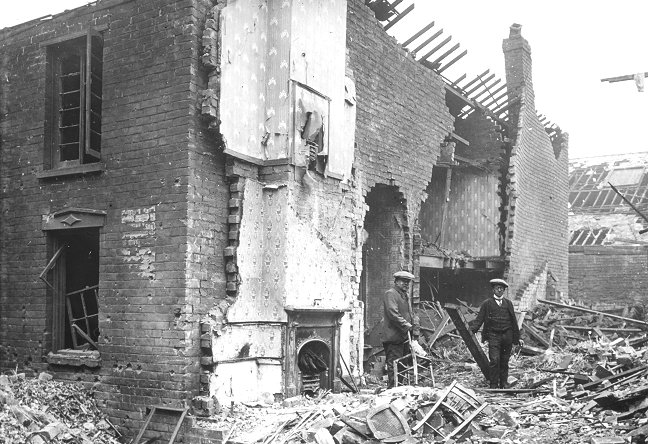
The bomb damage at number 14 and number 13
King Street, Wednesbury. From a magic lantern slide. |
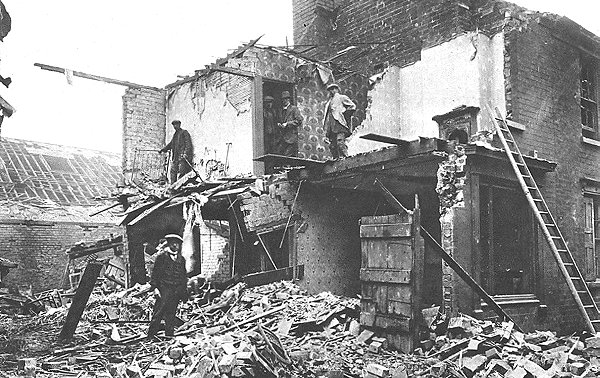
Another view of the damage in King
Street. From the Illustrated London News, 12th February,
1916. |
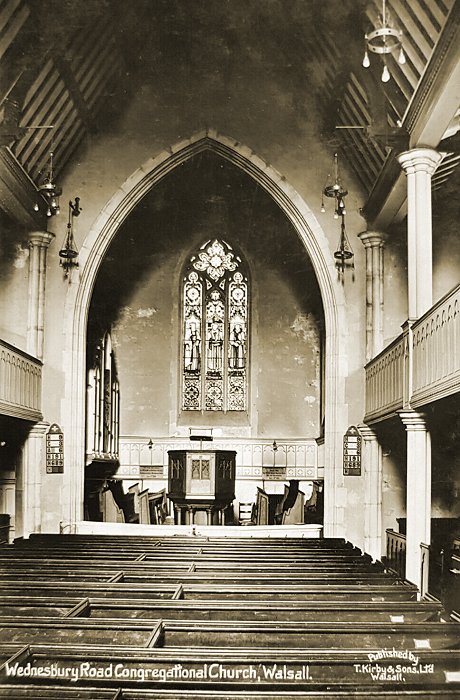
The interior of Wednesbury
Road Congregational Church. From an old postcard. |
Other bombs were dropped near
to the Crown and Cushion pub, in High Bullen, before
the Zeppelin moved away. Another thirteen people had
been killed, four men, four women and five children.
There is now a memorial to them in Wood Green
Cemetery. It has the following names:
Matilda Mary Burt aged 10, Mary
Emma Evans aged 5, Rachel Higgs aged 36, Susan
Howells aged 30, Mary Ann Lee aged 59, Frank
Thompson Linney aged 36, Albert Gordon Madeley aged
21, Betsy Shilton, aged 39, Edward Shilton aged 33,
Ina Smith, aged 7, Joseph Horton Smith, aged 37,
Nellie Smith, aged 13, and Thomas Horton Smith, aged
11.
L21 then headed in a north
easterly direction towards the lights of Pleck and
Walsall, dropping more bombs in Brunswick Park Road.
The next bomb was dropped on Wednesbury Road
Congregational Church, badly damaging the building.
At the time a preparation class from a local primary
school was at work in the church parlour.
Fortunately the parlour survived, only a small piece
of the ceiling fell into the room. Unfortunately Mr.
Thomas Merrylees aged 28, who was walking past the
church at the time, wasn’t so lucky. A piece of
flying rubble removed the top of his head, instantly
killing him. |
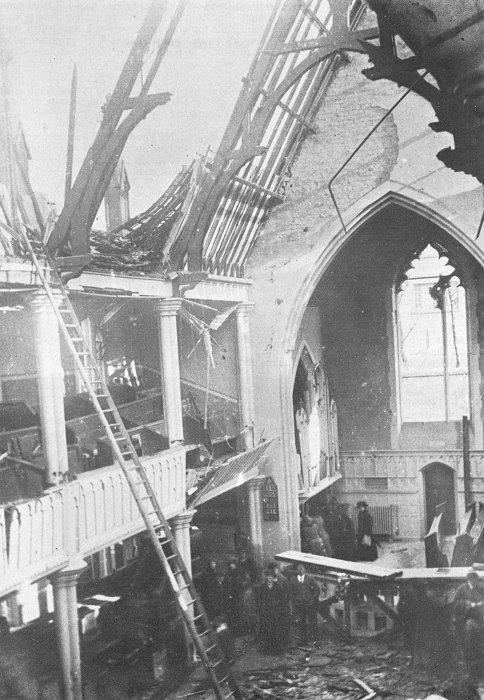
The church interior after the bombing.
|

The General Hospital and the
Congregational Church. From an old postcard. |
|
A short time later, an incendiary
bomb fell next door, in the grounds of the General
Hospital, which was quickly extinguished by a passing
policeman, Constable Joseph Burrell, who was on his beat.
He heard a strange sound and looked up to see the
Zeppelin overhead, dropping bombs as it went on its way.
He saw the two bombs that were dropped on the
Congregational Church about 80 yards away. Luckily his cape
helped to protect him from falling debris, and so he was only slightly injured. He then
saw flames coming from the hospital grounds and so
rushed inside to see an incendiary bomb burning between
the men's and women's wards, and managed to extinguish
it using a piece of wood. Afterwards he calmed the
patients and staff. The hospital later presented him
with an inscribed medal for his bravery. Because of the
heat from the burning bomb, his eyes were badly
affected. He went blind in 1924 as a result of his
injuries.
Another bomb damaged houses in Mountrath
Street, and another blew a hole in the wall of a saddle
maker’s workshop at the factory of Elijah Jefferies &
Sons Limited.
|
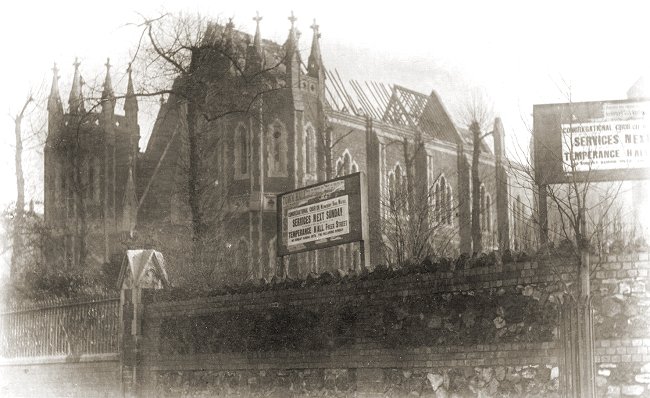
Wednesbury Road Congregational
Church after the bombing. The notices state that the
next service will be held in the Temperance Hall in
Freer Street. From an old postcard. |
|
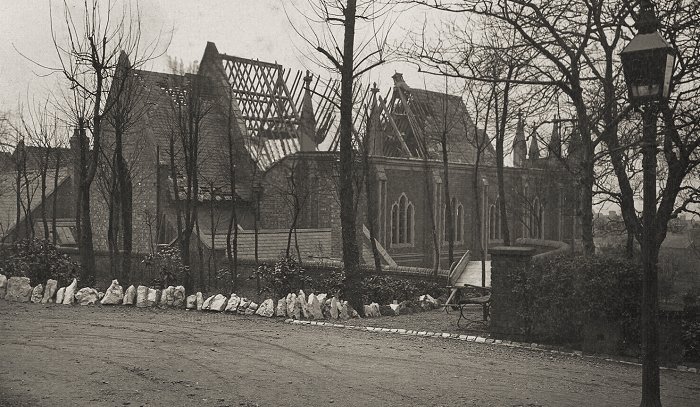
Another view of the bomb
damage. From an old postcard. |
|
Minutes later the L21 flew over
Bradford Place and dropped a final bomb outside the
Science and Art Institute in which many students were at
work. Only one of them, Mr. A. K. Stephens, who was
attending a chemistry class, suffered any injuries. He
was badly cut, possibly by flying glass, and treated in
the hospital.
Things weren’t so good outside. The
bomb wrecked the public toilets, and damaged tramcar
number 16, in which one of the passengers was the Lady
Mayoress of Walsall, 55 years old Mary Julia Slater,
wife of Samuel Mills Slater of Bescot Hall. She received
severe injuries to her chest and abdomen, from which she
never recovered. Sadly she died in hospital from shock
and septicaemia on February 20th. Three other people were
killed in the blast, and many were injured. The three
who died were Charles Cope aged 34, William Haycock aged
50, and John Powell aged 59.
|

Tramcar number 16 in which
Mary Julia Slater was travelling. The broken windows
from the explosion can clearly be seen. |
| The memorial to Mrs Slater,
and the shrapnel-damaged wall in Bradford Place. |
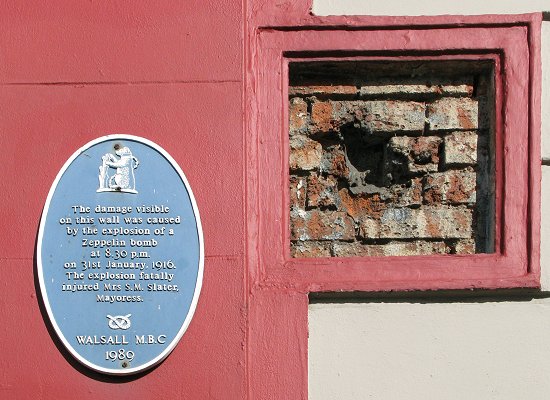 |
|
From the
Wolverhampton Chronicle, 23rd February, 1916:
Inquest on the body of
Midland Mayoress
At an inquest held on
Tuesday respecting the death of the Mayoress of
a Midland town, a victim of the Zeppelin raid,
evidence was given by the Mayor that he was
called to a certain street on Monday, January
31st. He saw his wife in a shop, having
sustained certain injuries. Two doctors were in
attendance, and she was afterwards taken to
hospital, and died at 5.40 on Sunday evening
last.
About a week after the
occurrence, the Mayoress told him that she was
coming into town in a tramcar with her sister
and sister-in-law. She sat in the corner of the
tram behind the driver. When they reached a
certain point the light suddenly went out, and
she felt she was hit. She got up, and found it
difficult to breathe. She thought there were
flames of gas in the tram. She managed to get
out, and made her way to the footpath, where she
was rejoined by her sister and sister-in-law.
The Mayoress told him she was sitting in the
tram when she was hit, and was not getting out.
A sister-in-law said that on the journey they
heard several violent explosions.
Medical evidence showed
that the Mayoress was found to be suffering from
severe wounds to the chest and abdomen. She was
bleeding freely, and after the haemorrhage had
been stopped she was taken to the hospital.
There was a lacerated wound on the left breast,
three inches long and 1½ inches in diameter,
another wound on the left side which had torn
away a portion of the ribs and had opened her
chest and abdomen, and there was another wound
lower down which had penetrated the bone.
Such wounds could have been
caused by splinters of bomb, but no portion of a bomb
had been discovered. Death was due to shock and
septicaemia following upon extensive wounds.
The Coroner said the
verdict of the jury would be that the deceased
died from the injuries spoken to, caused by
bombs dropped from mid-air. This was agreed
upon, and the foreman of the jury expressed deep
sympathy with the Mayor and family.
Coroner’s Comments
The Coroner remarked that
words failed one to express one’s abhorrence
that an unprotected woman going about her humane
duties should be cut off by the act of an enemy
– an act unparalleled, even by any story that
had come down from barbarous times. It might be
said of the Mayoress: “This was a women of good
works”, as was said of the Dorcas of old. The
Mayor had the deepest sympathy of all.
The Mayor, who was
accompanied by his soldier son (wounded),
returned thanks, and said how deeply his family
and himself were moved by the extraordinary
sympathy which had come to them from all the
people in the town. They knew his wife was
brought to the hospital, and on behalf of his
children and himself he wished to say how
grateful they felt to all associated with the
hospital for the unwearying devotion they had
shown towards his wife. He (the Mayor) had been
resident of the institution for nearly three
weeks, and he acknowledged the acts of kindness
which had made it easier to go through the time
of trial. The family would always feel with the
utmost gratitude all that had been done for his
wife, and for the family.
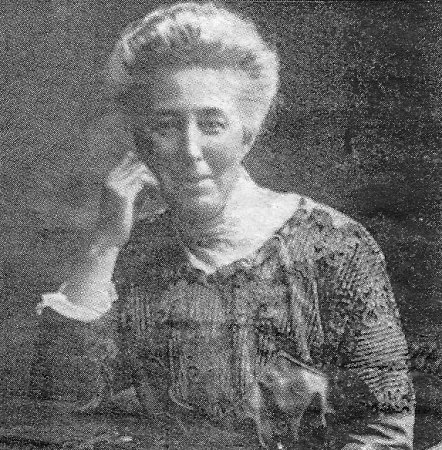
Mary Julia Slater. |
|
|
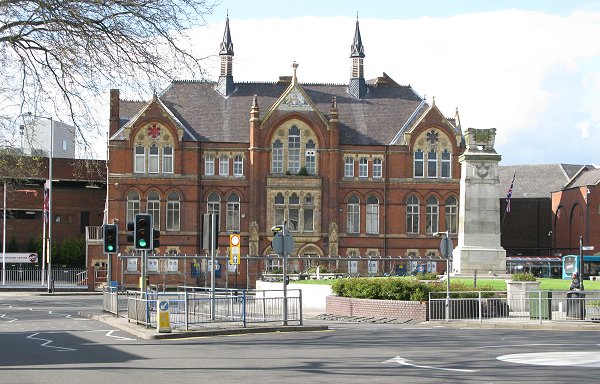
Bradford Place, the site of the
fatal bombing. |
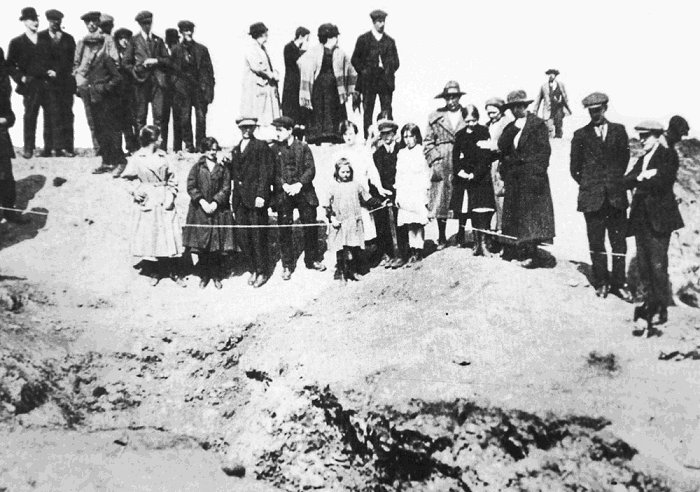
The bomb crater in Bradford
Place. From a cutting from an unknown newspaper.
|
After the bombing, L21 turned round
and headed back to its base at Nordholz in Germany, but
unfortunately that wasn’t the end. A second Zeppelin,
L19 under the command of Odo Loewe had made the same
navigational error as L21, and roughly followed its
flight path. It arrived around four and a half hours
later, reaching Tipton at about 12.30 a.m. The sight of
the still burning fires from the first raid convinced
Loewe that he had reached his target. The brand new
airship had only been flying for two months, and had
fallen behind because of teething problems with the
engines.
Again bombs were dropped, roughly
in the same places as before, but this time there were
no injuries or fatalities, other than to livestock. The
raid only lasted a short while. Bombs were dropped in
Tipton where The Bush Inn in Park Lane was
badly damaged, just after midnight on 1st
February. A bomb, dropped from L19
exploded in the road in front of the building.
The licensee, Thomas Taylor and his family were
cut by flying debris, but had a lucky escape.
The pub was rebuilt after the war and remained
in business until 1995. Bombs were also dropped
at Wednesbury and the Pleck, where a bomb fell on a stable
and killed
a horse, four pigs, and a number of fowl. Next in line
was Birchills where bombs seriously damaged St. Andrew’s
Church and vicarage.
As the airship began its journey
home, three of the engines failed. The airship attempted
to limp home to its base at Tonder in Denmark. As it
slowly crossed the North Sea it was fired on by the
Dutch. Rifle fire punctured some of its gas cells, and
L19 came down in the sea.
At first it looked as though the
sixteen crew members might be saved because the English
fishing trawler ‘King Stephen’ which had set sail from
Grimsby that morning, came across the sinking airship.
At the time the trawler was illegally fishing in
prohibited waters, and the captain, William Martin,
found himself in a dreadful dilemma.
|
|
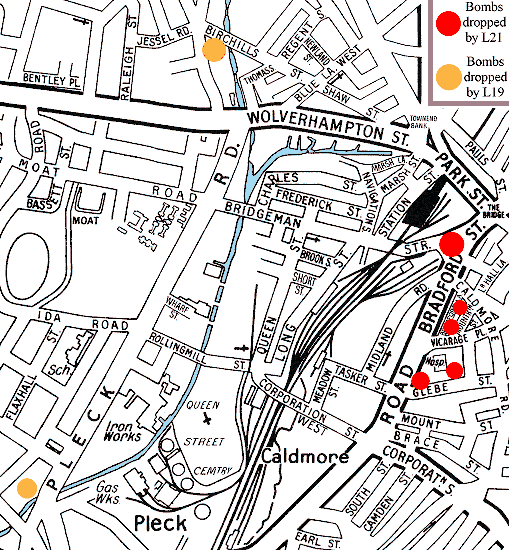
The sites that were bombed in
Walsall. |
Should he save the
Zeppelin crew and risk falling foul of the law, or carry
on regardless. Illegal fishing was a serious offence,
for which he could be banned from fishing.
He also had
to consider the possibility that the German crew could
overpower him and his men, and take-over the ship.
He decided to ignore the German’s
pleas for help, and continued on his way. He reported
the sighting when the ship reached port, but a
subsequent search by Royal Navy ships found nothing.
The
L19's crew were never seen alive again. In their last
hours the German crew dropped messages in bottles into
the sea, which washed up six months later in Sweden.
|
|
The incident received world-wide
publicity. Captain Martin was praised by many people for
protecting the safety of his crew, but others, including
members of the German press condemned him. The trawler
found itself on the German Naval High Command’s wanted
list, and even featured in German propaganda.
After the
ship’s return to Grimsby it was taken over by the Royal
Navy, and used as a Q-ship, under the command of
Lieutenant Tom Phillips. Twelve weeks later the ship was
sunk by a German torpedo boat and the crew became
prisoners-of-war.
Captain Martin died of heart
failure on 24th February 1927. During his last year he
received many letters, some praising his actions, but
also hate mail, and death threats.
The full extent of the damage to
buildings in Bradford Place could only be realised the
following morning. A piece of shrapnel can still be seen
embedded in the wall of the Colliseum Night Club where
there is a blue plaque to commemorate the death of the
Lady Mayoress.
There is also a memorial to her memory in
the form of a tablet in the Council House. Walsall’s
Cenotaph now stands on the spot where the bomb exploded.
The casing of one of the incendiary bombs is preserved,
and is in the collection at Walsall Museum.
|
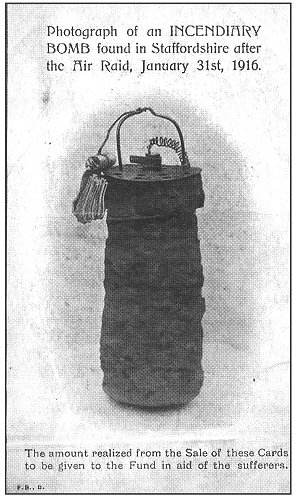 |
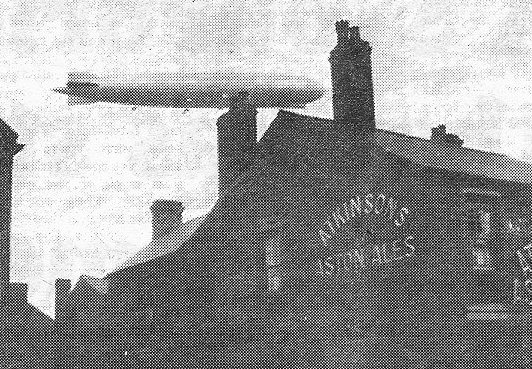
A 1930s Zeppelin, seen over the
Old Barrel pub on Kings Hill, Wednesbury. Courtesy of
David Adams. |
As a result of the raid, street lighting was
turned-off, and people had to shade all domestic
lights. A special steam warning siren was
installed in February, 1916 so that everyone in
the town centre could be warned of any future
air raids. In the event of an air raid, five
long blasts would be given twice. |
|
Factories were asked to arrange for a watchman to
be on duty throughout the night to listen for the siren.
He should then arrange for any furnaces to be damped
down. Factories were also asked not to use hooters of
buzzers between 3 p.m. and 5 a.m. If the siren sounded,
people were to turn any lights out, and anyone in the
street should take cover.
In July 1939, an unexploded bomb,
described as an "Aerial Torpedo" was discovered during
renovation work on a bridge near Kidderminster. It was
reported in an article in ‘The Times’ newspaper on 1st
August, 1939, and believed to have been dropped by L19.
|
|
| From the Express & Star,
Wednesday 2nd February, 1916:
AIR RAID DEATH ROLL
54 KILLED AND 67 INJURED BY
ZEPPELIN BOMBS
LARGEST AREA YET COVERED BY ENEMY
ATTACKS
Press Bureau, 6 p.m.
Tuesday night. The War Office issues the
following publication:
The air raid of last night
was attempted on an extensive scale, but it
appears that the raiders were hampered by thick
mist. After crossing the coast the Zeppelins
steered various courses, and dropped bombs at
several towns, and in rural districts, in:
Derbyshire, Leicestershire,
Lincolnshire, Staffordshire.
Some damage to property was
caused. No accurate reports were received until
a very late hour. The casualties notified up to
the time of issuing this statement amount to:
Killed
--------------------- 54
Injured
-------------------- 67
Further reports of Monday
night’s air raid show that the enemy’s air
attack covered a larger area than on any
previous occasion. Bombs were dropped in:
Derbyshire, Leicestershire,
Lincolnshire, Norfolk, Suffolk,
Staffordshire.
The number of bombs being
estimated at 220. Except in one part of
Staffordshire the material damage was not
considerable, and in no case was any military
damage caused.
No further casualties have
been reported, and the figures remain as 54
killed, 67 injured. |
|
|

A final view of a Zeppelin. From
the Illustrated War News, 12th April, 1915. |
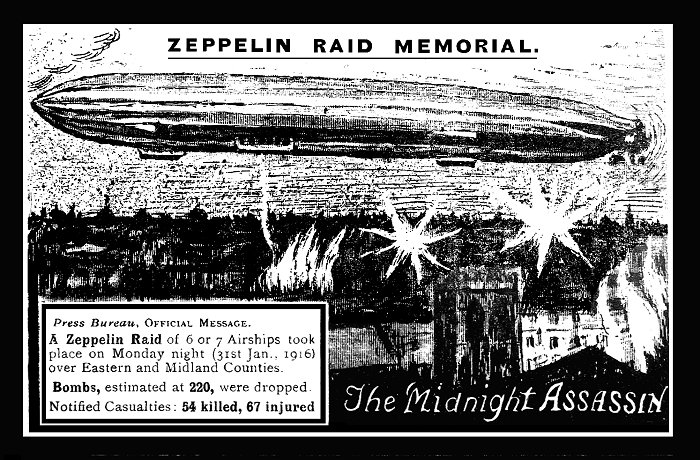
From an old postcard.
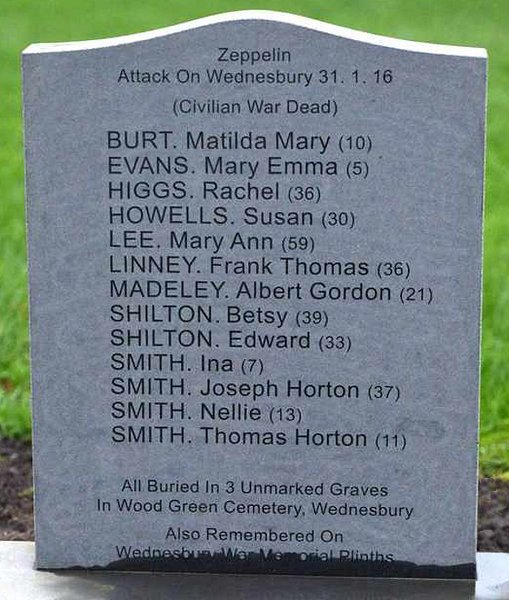 |
The memorial in Wood Green
Cemetery, Wednesbury, to those who lost their lives. |
|
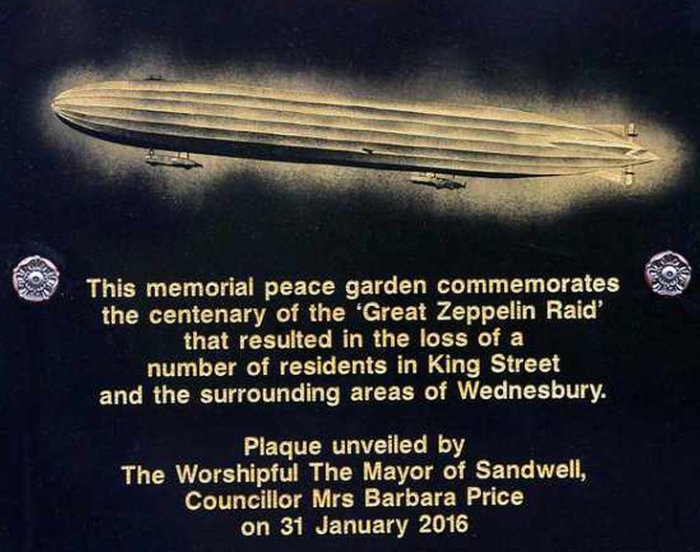
The plaque on the other
memorial in Wood Green Cemetery. |
 |
Return to the
previous page |
|